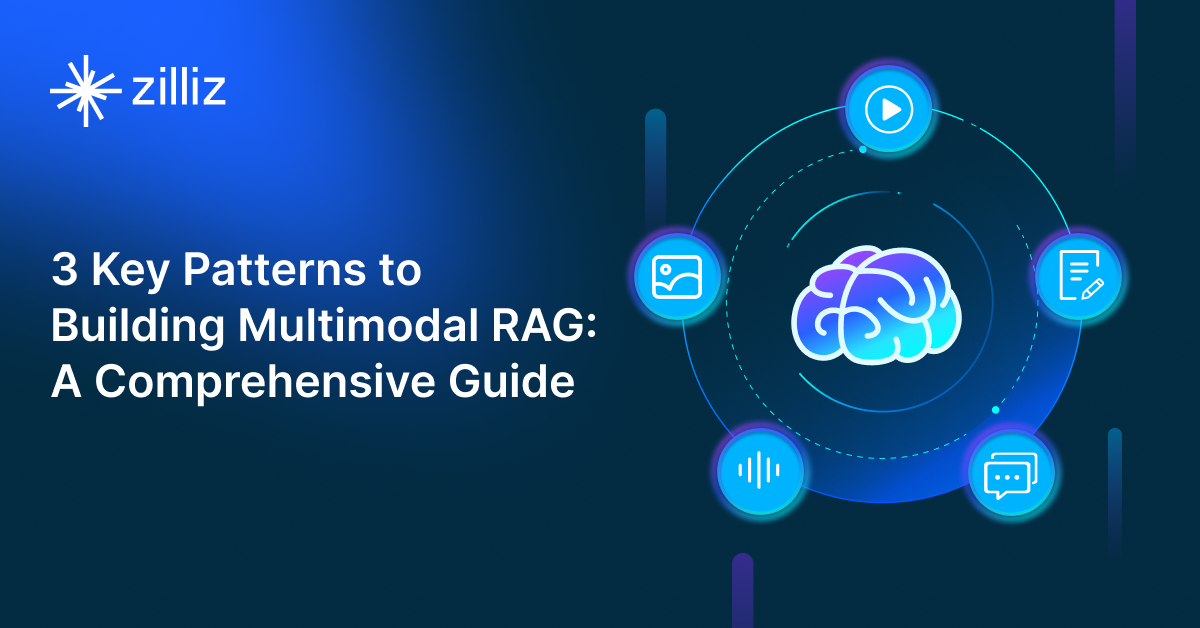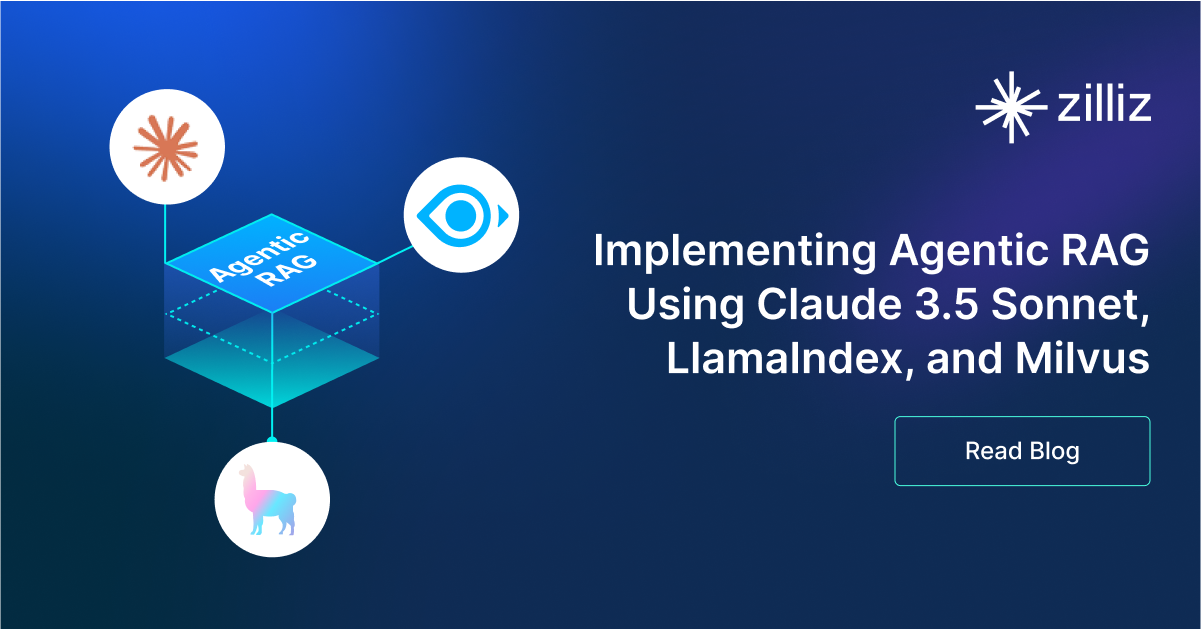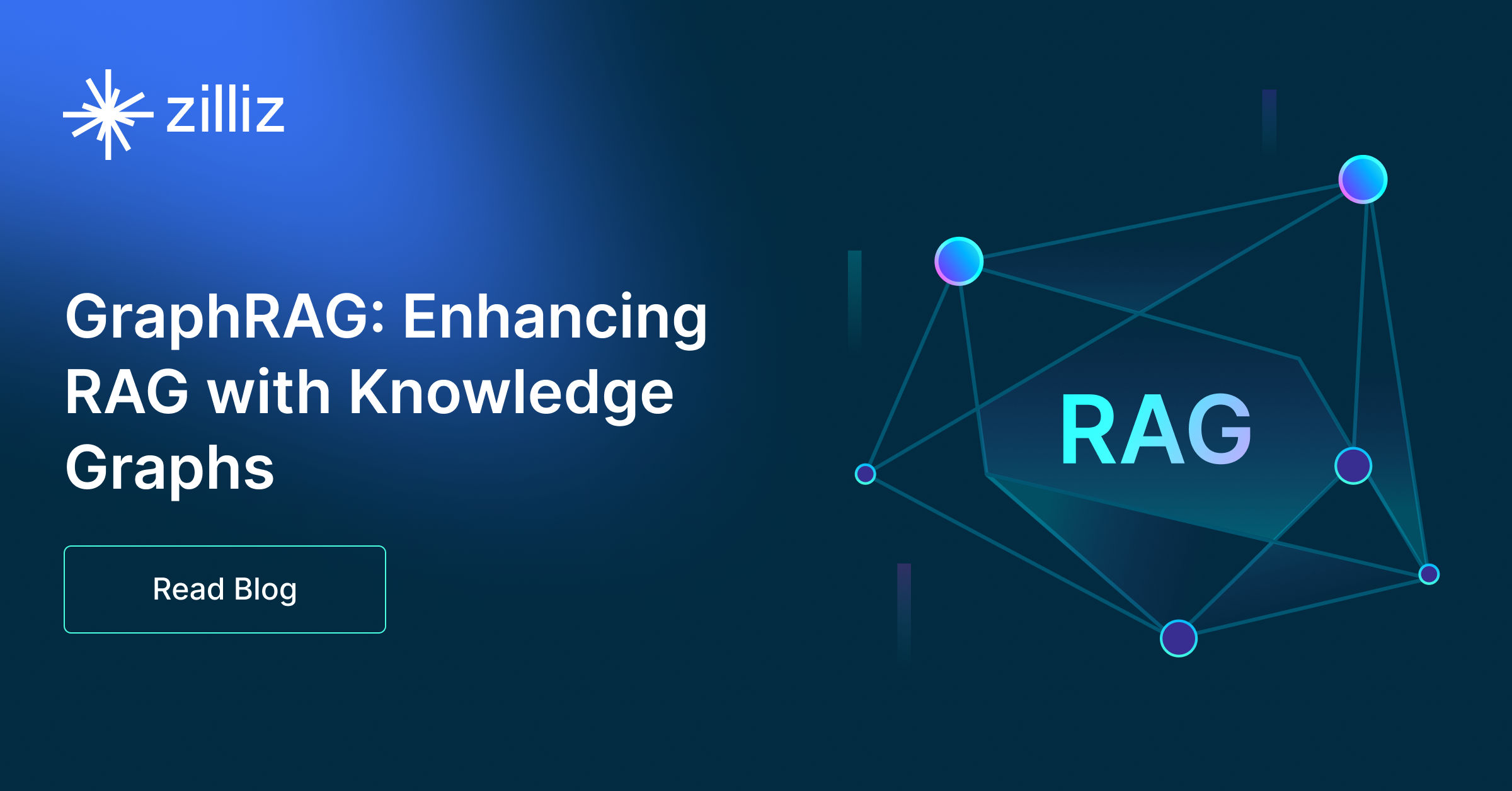Build RAG Chatbot with LangChain, OpenSearch, Anthropic Claude 3 Sonnet, and Ollama mxbai-embed-large
Introduction to RAG
Retrieval-Augmented Generation (RAG) is a game-changer for GenAI applications, especially in conversational AI. It combines the power of pre-trained large language models (LLMs) like OpenAI’s GPT with external knowledge sources stored in vector databases such as Milvus and Zilliz Cloud, allowing for more accurate, contextually relevant, and up-to-date response generation. A RAG pipeline usually consists of four basic components: a vector database, an embedding model, an LLM, and a framework.
Key Components We'll Use for This RAG Chatbot
This tutorial shows you how to build a simple RAG chatbot in Python using the following components:
- LangChain: An open-source framework that helps you orchestrate the interaction between LLMs, vector stores, embedding models, etc, making it easier to integrate a RAG pipeline.
- OpenSearch: An open-source search and analytics suite derived from Elasticsearch. It offers robust full-text search and real-time analytics, with vector search available as an add-on for similarity-based queries, extending its capabilities to handle high-dimensional data. Since it is just a vector search add-on rather than a purpose-built vector database, it lacks scalability and availability and many other advanced features required by enterprise-level applications. Therefore, if you prefer a much more scalable solution or hate to manage your own infrastructure, we recommend using Zilliz Cloud, which is a fully managed vector database service built on the open-source Milvus and offers a free tier supporting up to 1 million vectors.)
- Anthropic Claude 3 Sonnet: This advanced model in the Claude 3 lineup specializes in creative and nuanced text generation. With a deep understanding of context and tone, it is well-suited for applications in creative writing, dialogue generation, and storytelling. Its ability to produce articulate and engaging prose makes it ideal for content creation and entertainment.
- Ollama mxbai-embed-large: This advanced AI model specializes in generating high-quality embeddings for natural language processing tasks. Its strength lies in capturing nuanced meanings and relationships within text data, making it ideal for semantic search, recommendation systems, and content clustering applications.
By the end of this tutorial, you’ll have a functional chatbot capable of answering questions based on a custom knowledge base.
Note: Since we may use proprietary models in our tutorials, make sure you have the required API key beforehand.
Step 1: Install and Set Up LangChain
%pip install --quiet --upgrade langchain-text-splitters langchain-community langgraph
Step 2: Install and Set Up Anthropic Claude 3 Sonnet
pip install -qU "langchain[anthropic]"
import getpass
import os
if not os.environ.get("ANTHROPIC_API_KEY"):
os.environ["ANTHROPIC_API_KEY"] = getpass.getpass("Enter API key for Anthropic: ")
from langchain.chat_models import init_chat_model
llm = init_chat_model("claude-3-sonnet-20240229", model_provider="anthropic")
Step 3: Install and Set Up Ollama mxbai-embed-large
pip install -qU langchain-ollama
from langchain_ollama import OllamaEmbeddings
embeddings = OllamaEmbeddings(model="mxbai-embed-large")
Step 4: Install and Set Up OpenSearch
pip install --upgrade --quiet opensearch-py langchain-community
from langchain_community.vectorstores import OpenSearchVectorSearch
opensearch_vector_search = OpenSearchVectorSearch(
"http://localhost:9200",
"embeddings",
embedding_function
)
Step 5: Build a RAG Chatbot
Now that you’ve set up all components, let’s start to build a simple chatbot. We’ll use the Milvus introduction doc as a private knowledge base. You can replace it with your own dataset to customize your RAG chatbot.
import bs4
from langchain import hub
from langchain_community.document_loaders import WebBaseLoader
from langchain_core.documents import Document
from langchain_text_splitters import RecursiveCharacterTextSplitter
from langgraph.graph import START, StateGraph
from typing_extensions import List, TypedDict
# Load and chunk contents of the blog
loader = WebBaseLoader(
web_paths=("https://milvus.io/docs/overview.md",),
bs_kwargs=dict(
parse_only=bs4.SoupStrainer(
class_=("doc-style doc-post-content")
)
),
)
docs = loader.load()
text_splitter = RecursiveCharacterTextSplitter(chunk_size=1000, chunk_overlap=200)
all_splits = text_splitter.split_documents(docs)
# Index chunks
_ = vector_store.add_documents(documents=all_splits)
# Define prompt for question-answering
prompt = hub.pull("rlm/rag-prompt")
# Define state for application
class State(TypedDict):
question: str
context: List[Document]
answer: str
# Define application steps
def retrieve(state: State):
retrieved_docs = vector_store.similarity_search(state["question"])
return {"context": retrieved_docs}
def generate(state: State):
docs_content = "\n\n".join(doc.page_content for doc in state["context"])
messages = prompt.invoke({"question": state["question"], "context": docs_content})
response = llm.invoke(messages)
return {"answer": response.content}
# Compile application and test
graph_builder = StateGraph(State).add_sequence([retrieve, generate])
graph_builder.add_edge(START, "retrieve")
graph = graph_builder.compile()
Test the Chatbot
Yeah! You've built your own chatbot. Let's ask the chatbot a question.
response = graph.invoke({"question": "What data types does Milvus support?"})
print(response["answer"])
Example Output
Milvus supports various data types including sparse vectors, binary vectors, JSON, and arrays. Additionally, it handles common numerical and character types, making it versatile for different data modeling needs. This allows users to manage unstructured or multi-modal data efficiently.
Optimization Tips
As you build your RAG system, optimization is key to ensuring peak performance and efficiency. While setting up the components is an essential first step, fine-tuning each one will help you create a solution that works even better and scales seamlessly. In this section, we’ll share some practical tips for optimizing all these components, giving you the edge to build smarter, faster, and more responsive RAG applications.
LangChain optimization tips
To optimize LangChain, focus on minimizing redundant operations in your workflow by structuring your chains and agents efficiently. Use caching to avoid repeated computations, speeding up your system, and experiment with modular design to ensure that components like models or databases can be easily swapped out. This will provide both flexibility and efficiency, allowing you to quickly scale your system without unnecessary delays or complications.
OpenSearch optimization tips
To optimize OpenSearch in a Retrieval-Augmented Generation (RAG) setup, fine-tune indexing by enabling efficient mappings and reducing unnecessary stored fields. Use HNSW for vector search to speed up similarity queries while balancing recall and latency with appropriate ef_search and ef_construction values. Leverage shard and replica settings to distribute load effectively, and enable caching for frequent queries. Optimize text-based retrieval with BM25 tuning and custom analyzers for better relevance. Regularly monitor cluster health, index size, and query performance using OpenSearch Dashboards and adjust configurations accordingly.
Anthropic Claude 3 Sonnet optimization tips
Claude 3 Sonnet provides a balance between speed and accuracy, making it a versatile choice for RAG systems. Optimize retrieval efficiency by limiting the number of retrieved documents per query to avoid excessive context window usage, which can slow down response times. Use semantic chunking techniques to break documents into meaningful sections, ensuring that only the most relevant information is passed to the model. Adjust temperature and sampling parameters dynamically based on the complexity of user queries, with lower values for factual responses and higher values when generating creative text. Implement structured prompting to guide the model toward more precise answers, reducing ambiguity in responses. If integrating multiple models, use Sonnet as an intermediate option for moderately complex queries while reserving Opus for high-stakes reasoning tasks. Utilize Claude’s API optimizations, such as streaming, to enhance response time and system efficiency.
Ollama mxbai-embed-large optimization tips
To optimize the Ollama mxbai-embed-large component in a Retrieval-Augmented Generation (RAG) setup, consider fine-tuning the embedding model on domain-specific data to enhance relevance in retrieval tasks. Utilize batching for input queries to improve throughput and efficiency, and implement caching mechanisms for frequently accessed embeddings to reduce latency. Monitor and analyze performance metrics to identify bottlenecks and iteratively adjust hyperparameters, such as learning rate and embedding size, while leveraging mixed-precision training to balance accuracy and resource utilization. Finally, regularly update your embedded database with fresh data to maintain the accuracy of retrieval results, ensuring your RAG system remains effective and responsive.
By implementing these tips across your components, you'll be able to enhance the performance and functionality of your RAG system, ensuring it’s optimized for both speed and accuracy. Keep testing, iterating, and refining your setup to stay ahead in the ever-evolving world of AI development.
RAG Cost Calculator: A Free Tool to Calculate Your Cost in Seconds
Estimating the cost of a Retrieval-Augmented Generation (RAG) pipeline involves analyzing expenses across vector storage, compute resources, and API usage. Key cost drivers include vector database queries, embedding generation, and LLM inference.
RAG Cost Calculator is a free tool that quickly estimates the cost of building a RAG pipeline, including chunking, embedding, vector storage/search, and LLM generation. It also helps you identify cost-saving opportunities and achieve up to 10x cost reduction on vector databases with the serverless option.
 Calculate your RAG cost
Calculate your RAG cost
What Have You Learned?
By diving into this tutorial, you’ve unlocked the power of combining cutting-edge tools to create a Retrieval-Augmented Generation (RAG) system that’s both intelligent and efficient! You learned how LangChain acts as the glue, seamlessly orchestrating workflows between components like OpenSearch for lightning-fast vector searches, Anthropic Claude 3 Sonnet for generating human-like, context-aware responses, and Ollama’s mxbai-embed-large model for transforming text into rich numerical embeddings. This synergy lets you build a pipeline where data is retrieved smartly and answers are crafted with nuance—perfect for applications like chatbots, research assistants, or knowledge bases. You also saw how OpenSearch’s scalability and hybrid search capabilities ensure your system handles large datasets without breaking a sweat, while Claude 3 Sonnet’s advanced reasoning elevates the quality of generated content. Plus, those optimization tips—like tuning chunk sizes and balancing latency with accuracy—gave you actionable strategies to refine performance. And let’s not forget the free RAG cost calculator you explored, a game-changer for budgeting resources as you scale!
Now, armed with this knowledge, you’re ready to innovate! Whether you’re enhancing customer support, building a personalized learning tool, or experimenting with new use cases, your RAG pipeline is a launchpad for creativity. Remember, the magic happens when you iterate: tweak parameters, experiment with prompts, and layer in domain-specific data to make your system truly shine. The tools are in your hands, the possibilities are endless, and the AI community is buzzing with opportunities—so go build something amazing. Your journey into intelligent applications starts now—optimize fearlessly, experiment boldly, and watch your ideas come to life! 🚀
Further Resources
🌟 In addition to this RAG tutorial, unleash your full potential with these incredible resources to level up your RAG skills.
- How to Build a Multimodal RAG | Documentation
- How to Enhance the Performance of Your RAG Pipeline
- Graph RAG with Milvus | Documentation
- How to Evaluate RAG Applications - Zilliz Learn
- Generative AI Resource Hub | Zilliz
We'd Love to Hear What You Think!
We’d love to hear your thoughts! 🌟 Leave your questions or comments below or join our vibrant Milvus Discord community to share your experiences, ask questions, or connect with thousands of AI enthusiasts. Your journey matters to us!
If you like this tutorial, show your support by giving our Milvus GitHub repo a star ⭐—it means the world to us and inspires us to keep creating! 💖
- Introduction to RAG
- Key Components We'll Use for This RAG Chatbot
- Step 1: Install and Set Up LangChain
- Step 2: Install and Set Up Anthropic Claude 3 Sonnet
- Step 3: Install and Set Up Ollama mxbai-embed-large
- Step 4: Install and Set Up OpenSearch
- Step 5: Build a RAG Chatbot
- Optimization Tips
- RAG Cost Calculator: A Free Tool to Calculate Your Cost in Seconds
- What Have You Learned?
- Further Resources
- We'd Love to Hear What You Think!
Content
Vector Database at Scale
Zilliz Cloud is a fully-managed vector database built for scale, perfect for your RAG apps.
Try Zilliz Cloud for Free


